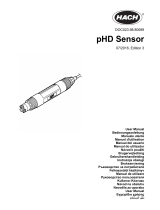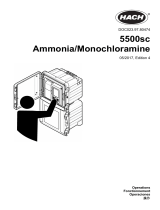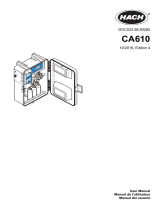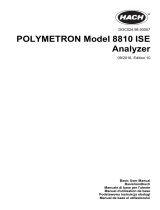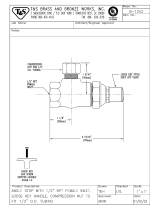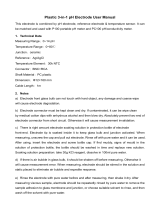Page is loading ...

48275-18
EC1000 PROCESS
pH/ORP SYSTEM
INSTRUCTION MANUAL
© Hach Company, 1994-1997. All rights are reserved. Printed in the U.S.A. al/dk 7/97 3ed

2

3
CERTIFICATION
Hach Company certifies this instrument was tested thoroughly, inspected, and found to
meet its published specifications when it was shipped from the factory.
The EC1000 Process pH/ORP System has been tested and is certified as indicated to the
following instrumentation standards:
Product Safety
Listed by ETL to UL Standard 3101-1 (Listing # H0492805390)
Certified by ETL to CSA Standard C22.2 No. 142 (ETLc Certification # H0492805390)
Certified by Hach Company to EN 61010-1 (IEC1010-1), supporting test records by
Intertek Testing Services
Immunity
EN 50081-2 (European Generic Immunity Standard) per 89/336/EEC EMC: Supporting
test records Amador (TUV Product Services), certified compliance by Hach Company.
Required Standard/s include:
IEC 801-2 & IEC 1000-4-2 Electro-Static Discharge
IEC 801-3 Radiated RF Electro-Magnetic Fields*
IEC 801-4 Electrical Fast Transients/Burst
Emissions
Emissions per 89/336/EEC EMC: Supporting test records by Intertek Testing Services
(ETL), certified compliance by Hach Company.
Required Standard/s include:
EN 55011 (CISPR 11) Emissions, Class B Limits
CANADIAN INTERFERENCE-CAUSING EQUIPMENT REGULATION, IECS-003, Class A
Supporting test records by Intertek Testing Services (ETL), certified compliance by
Hach Company.
This Class A digital apparatus meets all requirements of the Canadian Interference-
Causing Equipment Regulations.
Cet appareil numérique de la classe A respecte toutes les exigences du Règlement sur le
matériel brouilleur du Canada.
FCC PART 15, Class "A" Limits:
Supporting test records by Intertek Testing Services (ETL), certified compliance by
Hach Company.
This device complies with Part 15 of the FCC Rules. Operation is subject to the following
two conditions:
(1) this device may not cause harmful interference, and
(2) this device must accept any interference received, including interference that may
cause undesired operation.
* Electromagnetic Radiation of 3 Volts/meter or greater can cause instrument inaccuracy. For complete accuracy details in an
RF environment, refer to the Supplementary Compliance Information in this manual.

4
Changes or modifications to this unit not expressly approved by the party responsible for
compliance could void the user’s authority to operate the equipment.
This equipment has been tested and found to comply with the limits for a Class A digital
device, pursuant to Part 15 of the FCC Rules. These limits are designed to provide
reasonable protection against harmful interference when the equipment is operated in a
commercial environment. This equipment generates, uses, and can radiate radio frequency
energy and, if not installed and used in accordance with the instruction manual, may cause
harmful interference to radio communications. Operation of this equipment in a residential
area is likely to cause harmful interference, in which case the user will be required to
correct the interference at his own expense.
Shielded cables must be used with this unit to ensure compliance with the Class A FCC
limits. Because this instrument operates on and generates radio frequency energy,
interference to radio and television reception may occur. If such interference does occur,
the operator should take the necessary steps to correct the interference. The following
techniques of reducing the interference problems are applied easily.
1. Disconnect power from the EC1000 Controller to verify that it is the source of
the interference.
2. If the EC1000 Controller is plugged into the same outlet as the device with which it is
interfering, try another outlet.
3. Move the EC1000 Controller away from the device receiving the interference.
4. Reposition the receiving antenna for the device receiving the interference.
5. Try combinations of the above.
CERTIFICATION, continued

5
TABLE OF CONTENTS
CERTIFICATION ..........................................................................................................................................................3
SPECIFICATIONS ........................................................................................................................................................9
SAFETY PRECAUTIONS ..........................................................................................................................................13
OPERATION ..............................................................................................................................................................15
SECTION 1 GENERAL INFORMATION ...........................................................................................................17
1.1 Instrument Description ...........................................................................................................................................17
1.2 EC1000 pH/ORP Controller ...................................................................................................................................17
1.3 Electrolyte Pump ....................................................................................................................................................17
1.4 Hach One Process pH Electrode ............................................................................................................................ 21
1.4.1 Sodium Error .............................................................................................................................................. 21
1.5 Hach One ORP Electrode ....................................................................................................................................... 21
1.6 Industrial Process pH Electrode .............................................................................................................................22
1.7 Sample Handling System .......................................................................................................................................22
1.7.1 Submersible ................................................................................................................................................ 22
1.7.2 Flow-Thru Cell ........................................................................................................................................... 22
1.7.3 In-Line ........................................................................................................................................................22
1.8 Principle of Operation ............................................................................................................................................23
SECTION 2 OPERATION ......................................................................................................................................25
2.1 Operating the User-Programmable Setup ............................................................................................................... 25
2.1.1 Moving Around the Menu ..........................................................................................................................25
2.1.2 Editing a Setup Value .................................................................................................................................25
2.1.3 Restoring Default Settings .......................................................................................................................... 27
2.2 Setup Menu .............................................................................................................................................................28
2.2.1 Alarms ........................................................................................................................................................28
2.2.2 Recorder Output .........................................................................................................................................29
2.2.3 PID Output .................................................................................................................................................. 30
2.2.4 Recorder 2 ................................................................................................................................................... 33
2.2.5 Initial Setup .................................................................................................................................................33
2.2.5.1 Temperature Compensation Setup ............................................................................................... 33
2.2.6 Keylock ....................................................................................................................................................... 35
2.2.7 Reference Solution Timer ...........................................................................................................................36
2.2.8 Warnings ..................................................................................................................................................... 36
2.3 Calibration ..............................................................................................................................................................37
2.3.1 pH Calibration ............................................................................................................................................ 38
2.3.1.1 Two-Point Calibration with Auto Recognition of Hach Buffers ................................................. 39
2.3.1.2 One-Point Grab Sample Calibration ............................................................................................ 40
2.3.1.3 Calibration Procedure Variations ................................................................................................. 40
2.3.1.4 One Point Calibration with a Buffer ............................................................................................ 41
2.3.1.5 Calibration Review .......................................................................................................................41
2.3.2 Temperature Calibration .............................................................................................................................41
2.3.3 ORP Calibration/mV Zero ..........................................................................................................................42
2.3.3.1 Preamp Zero .................................................................................................................................42
2.3.3.2 ORP Electrode Check ..................................................................................................................43
2.3.3.3 mV Offset .....................................................................................................................................43

6
SECTION 3 SERIAL INTERFACE .......................................................................................................................45
3.1 Optional Serial Interface Board ..............................................................................................................................45
3.2 Data Communications Format/Setup ......................................................................................................................45
3.3 Print Format ............................................................................................................................................................45
3.4 Remote Input Commands .......................................................................................................................................46
SECTION 4 PID CONTROL ..................................................................................................................................49
4.1 pH Controller Basics ...............................................................................................................................................49
4.2 Instrument Settings .................................................................................................................................................49
4.2.1 Set Point ......................................................................................................................................................49
4.2.2 Dead Band ...................................................................................................................................................49
4.2.3 Preset ...........................................................................................................................................................49
4.3 Gain .........................................................................................................................................................................49
4.3.1 Reset (Integral) ............................................................................................................................................52
4.3.2 Rate (Derivative) .........................................................................................................................................52
4.3.3 Curve ...........................................................................................................................................................52
INSTALLATION/MAINTENANCE .....................................................................................................................55
SECTION 5 INSTALLATION ...............................................................................................................................57
5.1 Unpacking the Instrument .......................................................................................................................................57
5.2 Industrial Process pH Electrode Preparation ..........................................................................................................57
5.3 Mounting the Controller .........................................................................................................................................57
5.3.1 Panel Mounting ...........................................................................................................................................57
5.3.2 Wall Mounting ............................................................................................................................................59
5.3.3 Pole Mounting .............................................................................................................................................59
5.4 Mounting the Pump .................................................................................................................................................59
5.5 Installing the pH/ORP Electrode ............................................................................................................................60
5.5.1 In-Line Electrode Installation .....................................................................................................................62
5.5.2 Submersible Sensor Installation ..................................................................................................................62
5.5.3 Flow-Thru Cell Installation .........................................................................................................................62
5.6 Wiring the Meter .....................................................................................................................................................63
5.6.1 Wire Preparation .........................................................................................................................................64
5.6.2 Power ...........................................................................................................................................................65
5.6.2.1 Line Voltage Selection for Meter .................................................................................................66
5.6.3 Alarms .........................................................................................................................................................66
5.6.4 Recorder and Controller ..............................................................................................................................66
5.6.5 Electrode Wiring .........................................................................................................................................67
5.6.6 Electrode Output Connections ....................................................................................................................67
5.7 Pump Wiring ...........................................................................................................................................................68
5.7.1 Line Voltage Selection for Electrolyte Pump .............................................................................................69
SECTION 6 BASIC START-UP ..............................................................................................................................71
6.1 Introduction .............................................................................................................................................................71
6.2.1 Assembling the Electrolyte Line .................................................................................................................71
6.2.2 Connection to the Pump Module .................................................................................................................71
6.2.3 Connection to the pH Electrode ..................................................................................................................71
6.3 Purging the System .................................................................................................................................................72
6.4 Calibration ...............................................................................................................................................................73
SECTION 7 SERIAL INTERFACE .......................................................................................................................75
7.1 Installation ...............................................................................................................................................................75
7.2 RS-232C Interface Configuration ...........................................................................................................................77
7.3 Current Loop Configuration ...................................................................................................................................77
TABLE OF CONTENTS, continued

7
SECTION 8 ELECTRODE AND PUMP MAINTENANCE ............................................................................... 81
8.1 Electrode Maintenance ...........................................................................................................................................81
8.1.1 General Electrode Maintenance .................................................................................................................. 81
8.1.2 Removing Existing Electrode .....................................................................................................................81
8.1.3 Sensor Replacement ................................................................................................................................... 81
8.1.4 Replacing Electrolyte ................................................................................................................................. 82
8.1.5 Crystal Formation in Reference Tube ........................................................................................................84
8.1.6 Purging the System .....................................................................................................................................84
8.1.7 Storage and Conditioning ........................................................................................................................... 84
8.1.7.1 pH Electrode Storage and Conditioning ...................................................................................... 84
8.1.7.2 ORP Electrode Storage and Conditioning .................................................................................... 84
8.1.7.3 Industrial pH Electrode Shelf Life and Storage ........................................................................... 86
8.1.8 pH Electrode Cleaning ................................................................................................................................86
8.1.9 ORP Electrode Cleaning .............................................................................................................................87
8.1.10 Industrial pH Electrode Cleaning ............................................................................................................... 87
8.2 Pump Maintenance .................................................................................................................................................87
8.2.1 Changing Pump Tubing ..............................................................................................................................87
8.3 Fuse Replacement ................................................................................................................................................... 88
8.3.1 Meter Fuse Replacement ............................................................................................................................88
8.3.2 Pump Fuse Replacement ............................................................................................................................ 90
8.4 Pump Motor Replacement ......................................................................................................................................90
SECTION 9 TROUBLESHOOTING .....................................................................................................................91
9.1 Troubleshooting the EC1000 Controller ................................................................................................................91
9.1.1 Test Diagnostic Menu .................................................................................................................................91
9.1.2 Error Codes .................................................................................................................................................94
9.1.3 System Warnings ........................................................................................................................................95
9.2 Troubleshooting the pH Electrode ......................................................................................................................... 96
9.3 Troubleshooting the ORP Electrode ...............................................................................................................98
SECTION 10 SCHEMATICS ................................................................................................................................. 103
GENERAL INFORMATION ...............................................................................................................................107
REPLACEMENT PARTS .........................................................................................................................................109
HOW TO ORDER ......................................................................................................................................................113
REPAIR SERVICE ....................................................................................................................................................114
APPENDIX A Process pH Electrode Without Internal Preamp ........................................................................... 115
APPENDIX B Supplemental Compliance Information ......................................................................................... 117
INDEX ......................................................................................................................................................................... 119
TABLE OF CONTENTS, continued

8

9
SPECIFICATIONS
(Specifications subject to change without notice.)
CONTROLLER SPECIFICATIONS
Ranges: pH: -2 to 16 pH; mV: -2000 to +2000 mV; Temperature: -5 to +105 °C
Accuracy*: pH: ±0.02 pH; mV: ±1.0% of reading, ±35 mV non-calibrated;
Temperature: ±1.5 °C before calibration with electrode, ±0.4 °C after calibration with
electrode.
Resolution: pH: 0.01 pH; mV: 0.1 mV; Temperature: 0.1 °C
Repeatability: pH: ±0.02 pH; mV: ±0.1 mV; Temperature: ±0.2 °C
Temperature Calibration: 1 or 2 point with zero and slope adjustments
Temperature Compensation: -5 to +105 °C for Nearnst equation (auto/manual);
0 to 60 °C for auto buffer recognition
Solution Temperature Correction: Corrected to 25 °C, 0.1 to -0.1 pH units/°C slope
Operating Temperature: -10 to 60 °C
Storage Temperature: -40 to 60 °C
Humidity Range: 5 to 90% RH non-condensing
Relative mV Adjustment: The mV zero may be offset to any point in the ±2000 range
Alarms: Alarms 1 and 2: Usable in any of operating modes, (pH/mV/Temperature).
Programmable for either low or high set point alarm. Alarm relays SPDT with contacts
rated at 5A resistive load at 30 Vrms (42.4 Vpk).
Recorder Output: Isolated 4-20 mA (adjustable to 0-20 mA at 900 ohms)
Controller Output: Proportional, Integral, Derivative. Additional resistors can be used to
provide 0 to 10 V, 0 to 1 V, or 0 to 100 mV outputs.
Input/Output (optional): RS-232C and 20 mA current loop
Signal Average: 0 to 10 seconds
Reading Update: Every 0.4 seconds
Power Requirements: 115/230 Vac (±17%), 50/60 Hz, 8 watts
Controller Enclosure: NEMA 4X/IP66 (rear connections). Suitable for 1/2-inch conduit.
Wall, panel or pole mounted. For indoor use.
Controller Dimensions: 14.4 cm x 14.4 cm x 12.5 cm deep (5.67" x 5.67" x 4.9" deep).
Panel cutout size: 14 cm x 14 cm (5.5" x 5.5")
* Intermittent Electromagnetic Radiation of 3 Volts per meter or greater may cause measurement inaccuracy. For complete
accuracy details in an RF environment, see the Supplemental Compliance Information in this manual.

10
Hach One
®
PROCESS pH SPECIFICATIONS
pH Range: 0 to 14 pH
Accuracy*: pH: ±0.02 pH; Temperature: ±1.5 °C before calibration, ±0.4 °C after
calibration
Repeatability: pH: ±0.02 pH (calibrated at 25 °C and measured at 25 °C);
Temperature: ±0.2 °C
Temperature Range: 0 to 60 °C
Pressure Range: 0 to 35 psi (241 kPa)
Slope: 58 mV± 2 mV/pH units at 28 °C
Reference Element: Ag/AgCl double junction
Electrode Diameter: 28.6 mm (1.125") at tip
Electrode Length: 20.3 cm (8")
Reference Tubing Length: 6.1 m (20 feet) optional 50 feet
Cable Length: 6.1 m (20 feet). Expandable to 1000 feet
Submersion Application: Operational to a depth of 40 feet
Electrical Output: Two 4-20 mA current loops, directly proportional to mV and
temperature
Electrode Housing: Kynar (lower body)/Noryl (polyphenylene oxide) (upper body)
Hach One ORP ELECTRODE SPECIFICATIONS
mV Range: -2000 to 2000 mV
Temperature Range: 0 to 60 °C
Pressure Range: 0 to 35 psi (241 kPa)
Accuracy*: mV: ±10 mV; Temperature: ±1.5 °C before calibration, ±0.4 °C after
calibration
Repeatability: mV: ±2 mV; Temperature: ±0.2 °C
Sensing Element: Platinum disc (99.998% pure)
Reference Element: Ag/AgCl double junction
Reference Potential: 32 ±5 mV vs. SCE
Electrode Diameter: 28.6 mm (1.125") at tip
Electrode Length: 20.3 cm (8")
Reference Tubing Length: 6.1 m (20 feet) optional 50 feet
Cable Length: 6.1 m (20 feet). Expandable to 1000 feet
Submersion Application: Operational to a depth of 40 feet
Electrical Output: Two 4-20 mA current loops, directly proportional to mV and
Temperature
Electrode Housing: Kynar (lower body)/Noryl (polyphenylene oxide) (upper body)
* Calibrated at 25 °C and measured at 25 °C and at atmospheric pressure.
SPECIFICATIONS, continued

11
INDUSTRIAL PROCESS pH ELECTRODE SPECIFICATIONS
pH Range: 0 to 12 pH
Reproducibility: ±2% of reading
Temperature and Pressure Range: 0 to 80 °C at 0 to 100 psig; 0 to 100 °C at
ambient pressure
Slope: (pH 4 to pH 7) @ 25 °C: >170 mV
Reference Element: Ag/AgCl
Electrode Diameter: 28.2 mm (1.11") at tip
Electrode Length: 175 mm (6.9")
Electrode Housing: CPVC
PUMP MODULE SPECIFICATIONS
Pressure Range: 0 to 35 psi (241 kPa)
Operating Temperature Range: -20 to 60 °C
Humidity Range: 5 to 90% RH non-condensing
Reagent Usage: Reference solution capacity for a minimum of 1 month of operation
Power Requirements: 115/230 Vac (±17%), 50/60 Hz, 9 VA, 8 watts
Enclosure: NEMA 4X/IP66—Wall mounting, with 1/2-inch NPT for conduit
connections. For indoor use.
MOUNTING KIT SPECIFICATIONS
SUBMERSION APPLICATION
Maximum Submersion Depth: 40 feet (due to restrictions on reference tubing length)
Maximum Velocity at Electrode Tip: 15 km/hour
IN-LINE APPLICATION
Maximum Pressure: 35 psi (241 kPa)
Maximum Flow Rate: 40 L/minute
Minimum Flow Rate: 10 mL/minute
FLOW-THRU CELL APPLICATION
Maximum Flow Rate: 750 mL/minute
Minimum Flow Rate: 1 mL/minute
SPECIFICATIONS, continued

12

13
SAFETY PRECAUTIONS
Before attempting to unpack, set up, or operate this instrument, please read this entire
manual. Pay particular attention to all warnings, cautions and notes. Failure to do so could
result in serious injury to the operator or damage to the equipment.
To ensure the protection provided by this equipment is not impaired, this equipment
MUST NOT be installed or used in any manner other than that which is specified in
this manual.
Use of Hazard Information
If multiple hazards exist, the signal word corresponding to the greatest hazard shall
be used.
DANGER
Indicates a potentially or imminently hazardous situation which, if not avoided, could result in
death or serious injury
CAUTION
Indicates a potentially hazardous situation that may result in minor or moderate injury
NOTE
Information that requires special emphasis
Precautionary Labels
Please pay particular attention to labels and tags attached to the instrument. Personal
injury or damage to the instrument could occur if not observed.
This symbol, if noted on the instrument, references the instruction manual for
operational and/or safety information.
Section 5.4 Installing the pH/ORP Electrode
Section 5.5 Wiring Meter
Section 5.5.2 Power
Section 5.6 Wiring Pump
Section 7.1 Installation
Section 8.1.7 pH Electrode Cleaning
Section 8.1.8 ORP Electrode Cleaning
Section 8.1.9 Industrial pH Electrode Cleaning

14

WARNING
Handling chemical samples, standards, and reagents can be dangerous. Review the necessary
Material Safety Data Sheets and become familiar with all safety procedures before handling
any chemicals.
ADVERTENCIA
La manipulación de muestras químicas, patrones y reactivos puede ser peligrosa. Antes de
manipular cualquier productor químico, conviene leer las Fichas Técnicas de Seguridad y
familiarizarse con los procedimientos de sugeridad.
ADVERTÊNCIA
A manipulação de amostras, padrões e reagentes químicos pode ser perigosa. Reveja as necessárias
Fichas Técnicas de Segurança do Material e familiarizese com os procedimentos de segurança
antes de manipular quaisquer substãncias químicas.
ATTENTION
La manipulation des échantillons chimiques, étalons et réactifs peut être dangereuse. Lire les fiches
de données de sécurité des produits nécessaires et se familiariser avec toutes les procédures de
sécurité avant de manipuler tout produit chimique.
WARNHINWEIS
Da das Arbeiten mit chemikalischen Proben, Standards, Reagenzien und Abfällen mit Gefahren
verbunden ist, empfiehlt die Hach Company dem Benutzer dieser Produkte dringend, sich vor der
Arbeit mit sicheren Verfahrensweisen und dem richtigen Gebrauch der Chemikalien oder
Biogefahrgut vertraut zu machen und alle entsprechenden Materialsicherheitsdatenblätter
aufmerksam zu lesen.
15
OPERATION

16

17
SECTION 1 GENERAL INFORMATION
1.1 Instrument Description
The EC1000 Process pH/ORP Monitoring System consists of the Series EC1000
Controller, a Hach One Pump Module, and a Hach One Process pH or ORP Electrode
assembly. The system monitors a sample stream for its pH value within the range of 0 to
14, or its millivolt potential from -2000 to +2000 mV, and its temperature ranging from
0 to 60 °C. The system also indicates when preset high and low alarm limits are exceeded,
provides relay closures for external devices, and provides output currents to drive a
recorder and remote process control equipment. Each of these items are described in
detail in the following sections.
1.2 EC1000 pH/ORP Controller
The controller is menu driven with PID capability and is housed in a NEMA 4X/IP66
enclosure (see Figure 1 on page 18). It is set up to receive two current loop inputs from a
pH or ORP probe preamplifier, and to provide a continuous readout of the sample pH or
millivolt value as well as the sample temperature. Output capabilities of the controller
include two 4-20 mA outputs for recording and controlling pumps and optional RS-232C
and 20 mA current loop serial port. Alarm features include user programmable Alarm 1
and Alarm 2 setpoint selections for any one of the operating modes (pH, millivolt, or
temperature) with SPDT relay contacts. The alarm can be a combination of
operating modes:
(Example 1)
Alarm 1-pH High Alarm
Alarm 2-Temperature High Alarm
(Example 2)
Alarm 1-pH Low Alarm
Alarm 2-Temperature Low Alarm
The EC1000 Controller can be mounted up to 1000 feet from the electrode. The pump
module can be mounted up to 50 feet from the electrode.
1.3 Electrolyte Pump
Note: The electrolyte
pump is not used with the
self-pressurized Industrial
Process pH Electrode with
self-pressurized
electrolyte, Cat. No.
48276-00. See Section 1.6
Industrial Process pH
Electrode.
The pump used on this system is a low pressure linear peristaltic pump, which operates up
to 35 psi. The pump is housed in a NEMA 4X enclosure, and allows for a maximum of
50 feet separation from the electrode. It continuously pumps electrolyte through a free-
flowing junction in the electrode (500 mL of electrolyte [Cat. No. 24291-49]) lasts
approximately 30 days). The pump module contains a refillable electrolyte reservoir (see
Figure 2 on page 20).

18
Figure 1 Controller Front Panel

19
Table 1 Controller Front Panel
Item Name Function
1 LED Display Main display field. Consists of eight 14-segment alpha-numeric 0.54″ high red LED characters.
During normal operation, this field displays either the pH or mV value (depending on the mode of
operation selected). This field also displays menu messages, edit menu values, and error messages.
See
Figure 1
.
2 Secondary
Display Field
The secondary display field consists of three 7-segment numeric 0.3″ high green LED digits.
During normal operation, this field displays temperature. In the setup menu, this field displays
abbreviations to help indicate which branch of the setup menu the operator is in. See
Figure 1.
3 SETUP key This key enters the setup menu. The setup is entered when it is pressed.
4 pH/mV key During normal operation (instrument displaying pH/mV), this key toggles the reading between
pH and mV. If the instrument is in any of the menus, pressing this key returns the instrument to
normal operation.
5 ENTER key This key, within the menus, either moves a level deeper into the menus, or accepts an edited selection.
6 CLEAR key This key, within the menus, either clears changes in an edit portion of a menu, or backs up one menu
level. If this instrument is in an edit portion of a menu selection, and the value is changed, then this key
restores the original value. Otherwise, this key causes the menu selection to back up one level; if the
menu is at the top level, this key returns the instrument to normal operation (instrument
displaying pH/mV).
7 RIGHT
ARROW key
This key, in an edit portion of a menu selection, selects the next digit to the right to edit. The selected
digit flashes. When the instrument is in one of the non-editing portions of the calibration/setup menus,
or in normal operation (instrument displaying pH/mV), this key is not valid; if pressed, an INVALID
message flashes on the main display.
8 HOLD/DOWN
ARROW key
During normal operation (instrument displaying pH/mV), this key functions as a hold. When pressed,
the outputs (alarm relays, recorder, and controller outputs) alternately hold at the current value, or
release to normal operation. When the outputs are held, the first character in the main display
flashes an H. (
Note: The H appears only during normal operation; in the menus, the H does not
appear.
) After the outputs are in the hold state for 30 minutes, they automatically release. When
the instrument is in one of the calibration/setup menus, this key scrolls down through the menu
selections. When the instrument is in an edit portion of a menu selection, this key decreases the
selected (flashing) digit.
9 ALARM ACK/
UP ARROW
key
During normal operation (instrument displaying pH/mV), this key functions as an alarm acknowledge.
When pressed, the alarms are alternately disabled or enabled. When the alarms are disabled, the
three alarm indicators flash, and the alarm relays are in the non-alarm state. After the alarms are
disabled for 30 minutes, they automatically enable. When the instrument is in one of the
calibration/setup menus, this key scrolls up through the menu selections. When the instrument is in an
edit portion of a menu selection, this key increases the selected (flashing) digit.
10 CAL key This key enters the calibration menu. From this menu, the pH electrode, temperature probe, and mV
offset can be calibrated, and the calibration reviewed.
11 System warning Red LED. Indicates a probe failure or controller malfunction. Refer to Table 4 on page 42 for specific
system warnings that appear on the main LED display. For most system warnings, the user must query
the system to determine the warning. See
Figure 1
.
12 Alarm 2 Red LED. User programmable setpoint alarm. See
Figure 1.
13 Alarm 1 Red LED. User programmable setpoint alarm. See
Figure 1.

20
Figure 2 Pump Module
/
